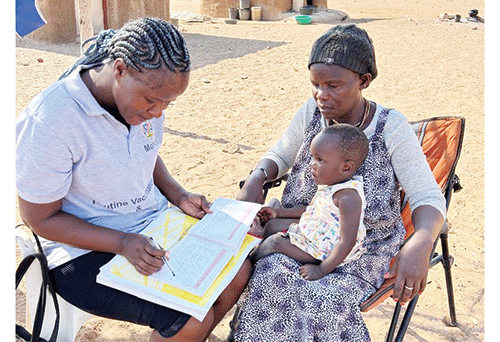The World Health Organisation (WHO) and its stakeholders have been conducting outreach programmes in Kunene to sensitise people about health and nutrition.
A resident of Okahozu, Vekoruavi Tjambiru, said she is elated that her 11-month-old baby was checked and is in good health.
“I am so happy that my baby was thoroughly checked because I felt the child was malnourished, according to the body. What is usually fed to the baby is goat milk, in addition to breastfeeding,” she shared.
She would breastfeed until he turns two years old.
WHO, in partnership with the Government of Japan, is supporting the health ministry in enhancing access to quality nutrition services.
This project targets vulnerable populations, including women and children in the Omaheke, Khomas and Kunene regions.
It will continue until November 2024.
Stay-at-home mother of eight Uakahoka Matundu from Otjerunda said her means of survival is the monthly grants from the government, which are used to feed her family.
“The last-born is two years, and I have been receiving this nutritional information for about five years now. It has been useful, and we are happy. One gets to be well-informed of steps to take once a child is sick,” she said.
She noted that the medication, regular check-ups, mosquito nets and overall information have been uplifting.
“I would like the team to continue sensitising people about the importance of maintaining a healthy lifestyle,” she stated.
The WHO noted that the nutrition crisis for children and young mothers in Namibia has worsened due to challenges from the Covid-19 pandemic.
On top of that, Namibia’s vulnerability to climate change is exacerbating food insecurity.
Unpredictable weather, long droughts and environmental damage have disrupted food production and increased the risk of malnutrition.
These challenges have heightened existing issues, especially for poor and marginalised communities, making it urgent to address malnutrition and its harmful effects on the population of Namibia.
The latest national data indicates an increase in children under five seen with malnutrition in hospital outpatient departments and primary healthcare facilities across the country. Within the period of January-March 2023, outpatient malnutrition cases have increased from 666 to 776.
Between April and June 2023, malnutrition cases fluctuated, with the highest number of cases of 839 reported in April 2023.
Notably, in the same period, 4 188 malnutrition cases were reported, with the Omaheke, Khomas and Kunene regions accounting for 29% (1 165) of these cases.
A community healthcare worker from Otjerunda, Anna-Marie Tjituri, said their main goal has been to assess children who are five-years-old.
“We look at the weight and height, and we also look at their medical reports to determine whether they have missed any vaccinations. If they are late for that, then we inform the mother about the importance of getting children of that age immunised against potential diseases,” said Tjituri, who is stationed at Rumana Clinic.
She said another group of people who need medical attention are expectant women.
The team ensures that they are well-informed about frequent hospital visits.


